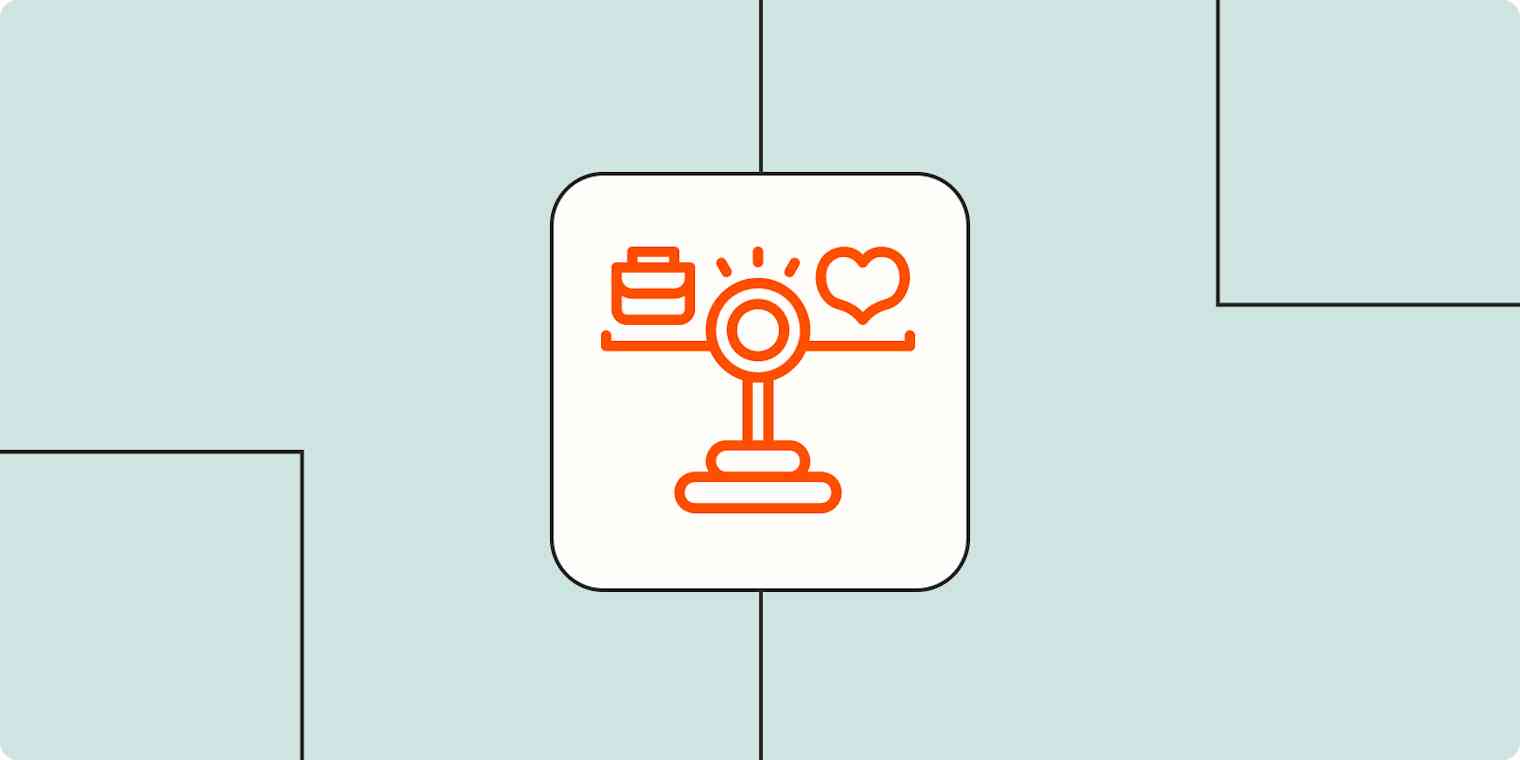There's never enough time to do everything you want to do. It's a universal problem. And we all accept that fact and live with its reality until the worst-case scenario rears its ugly head: there's not enough time to do everything you have to do.
When everything on your to-do list feels like it's of crucial importance (or when someone you answer to feels that way), use one or more of these prioritization techniques to help you identify your most important task and get work done.
What is a prioritization technique?
A prioritization technique helps you make informed decisions about the order you should complete your tasks based on different factors like their importance and due dates. With a list of prioritized tasks in hand, you have a shield to respectfully push back against unnecessary meeting invites and last-minute requests.
For example, when stakeholders would approach my teammates with "urgent" requests, we would show them our prioritized task list and ask, "What should we cut in order to accommodate this request?" After seeing the importance of the other things on the list, urgent requests often suddenly became much less urgent.
But prioritization techniques aren't limited to regaining control over workplace tasks. They're also useful for managing competing priorities from your family, friends, and even that part of your brain that's always on the lookout for side projects.
How to prioritize tasks: 10 task prioritization techniques
Much like identifying your working style, finding the right technique for prioritizing tasks is personal. If there's a specific method you're interested in learning about, feel free to jump ahead. Otherwise, keep scrolling to explore the different options and choose the ones that feel right for you.
Task prioritization techniques
1. Priority matrix
The priority matrix technique consists of distributing your tasks across a four-quadrant matrix like the one shown below. The x-axis represents one value, and the y-axis represents another. Each quadrant, then, represents priority based on the defined values.

There are infinite ways you could organize your priority matrix. Here are popular priority matrix examples to get you started.
Eisenhower matrix
With the Eisenhower matrix, the x-axis represents urgency while the y-axis represents importance, leaving you with the following categories (from the top-left going clockwise):
Important but not urgent tasks are lower priorities that you should add to your to-do list for later.
Important and urgent tasks are your top priorities.
Urgent but not important tasks are ones that must get done but can be delegated to someone else.
Not urgent or important tasks are probably unnecessary distractions.
To use it, evaluate each task based on its urgency and importance, and then place the task in the corresponding quadrant.
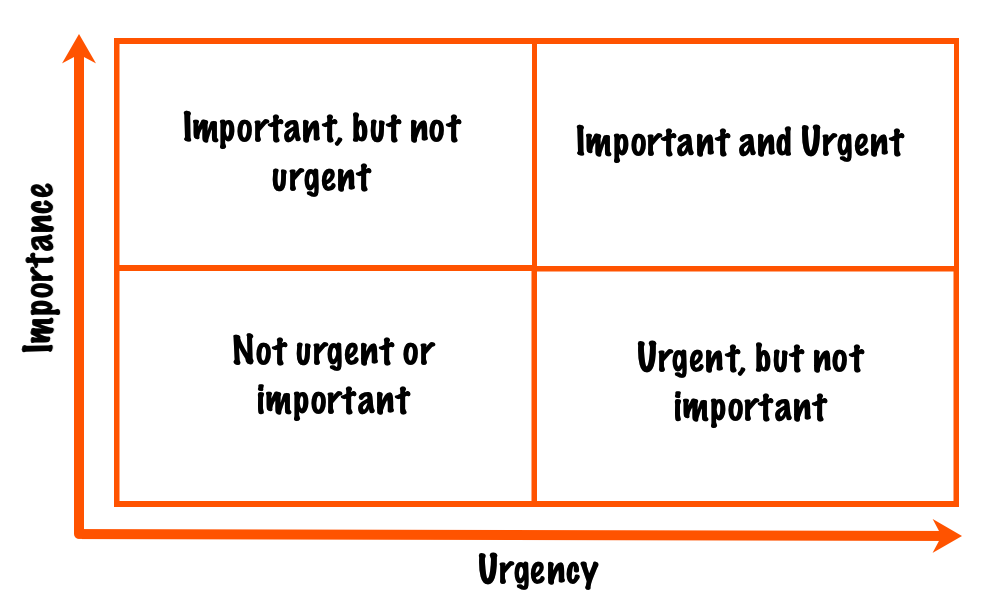
By placing each task on your list into a quadrant on the Eisenhower Matrix, you can determine what needs to be done now, what you can save for later, what's worth delegating, and what you can scratch out altogether.
Impact effort matrix
In the impact-effort matrix, the x-axis represents impact, and the y-axis represents effort. So you'll have a matrix with the following quadrants (from top-left going clockwise):
High effort, low impact
High effort, high impact
Low effort, high impact
Low effort, low impact
To distribute your tasks accordingly, evaluate how much effort each one will take and the impact completing it will have. Any tasks in your Low effort, high impact quadrant are your top priorities, followed by ones in your High effort, high impact quadrants.
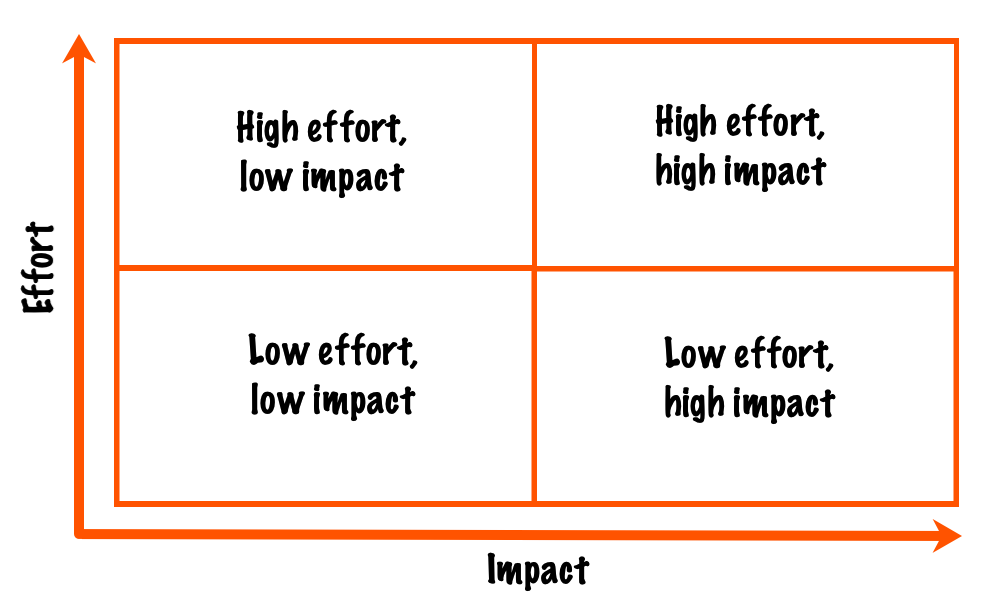
If you have a lot of tasks in these two quadrants, consider working on one or two from your Low effort, high impact quadrant. The sense of accomplishment from checking off these quick wins might give you that much-needed boost to tackle the rest.
Cost value matrix
In the cost-value matrix, the x-axis represents cost, and the y-axis represents value, leaving you with the following groupings (from top-left going clockwise):
High value, low cost
High value, high cost
Low value, high cost
Low value, low cost
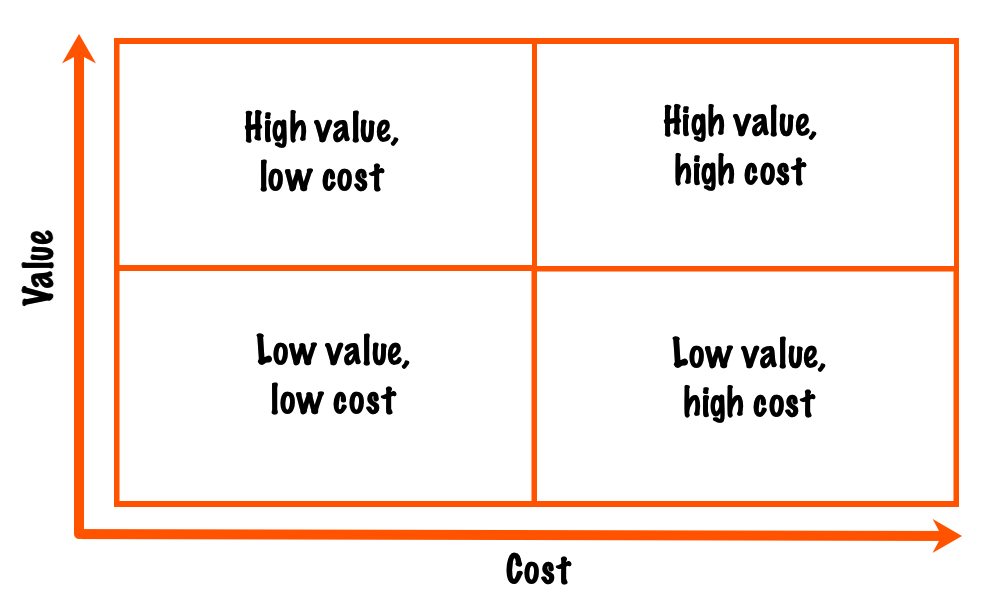
Evaluate how much your task will cost (in terms of time) and the value it'll provide. Tasks in your High value, low cost quadrant are your quick wins, while ones in your Low value, high cost are tasks you should probably avoid.
With any of the matrix models above, you can sketch them out on paper or in a spreadsheet. Or you can use an app that has built-in features for building priority matrices, like TickTick.
2. MoSCoW prioritization method
The MoSCoW method is a simple technique for prioritizing tasks where you assign every task on your to-do list to one of four categories:
M – Must do: M tasks are things you absolutely have to do.
S – Should do: S tasks are things you should do, but they're a lower priority than M tasks.
C – Could do: C tasks are nice-to-dos. You'd like to do them, but if you don't, it's probably not a big deal.
W – Won't do: W tasks are things that just aren't worth doing.
Note: If you have a lot of tasks that need delegation, the MoSCow method isn't for you. Jump to the ABCDE method for a better-suited alternative technique.
After you've assigned each task to a category, delete your W tasks. Breathe a sigh of relief at how much shorter your task list is now. Then get to work. Focus first on M tasks, followed by S tasks, and if you have time, C tasks.
By working on your list from the top down, you can ensure that you're always working on your highest-priority tasks.
For a seamless way to visualize and organize your tasks, try using a Kanban app like Trello or KanbanFlow. Create a list of unsorted tasks, and then drag each task into the appropriate category. You can also drag and drop tasks up and down within lists to specify the order in which you want to work on them.
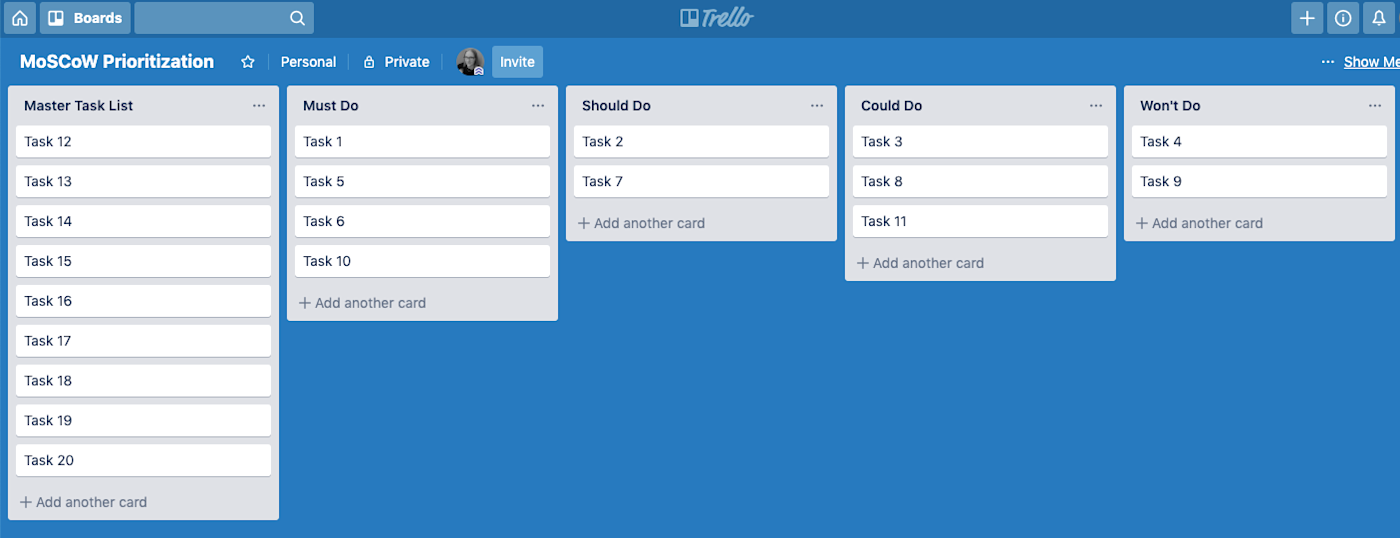
But for the MoSCoW method to really work, you have to make sure all your tasks actually get added to your board, so you can categorize them. With Zapier, you can automate this process by connecting your Kanban app with your task sources, like Slack or your email inbox. Learn more about how to automate your Kanban board, or get started with one of these workflows.
To get started with a Zap template—what we call our pre-made workflows—just click on the button. It only takes a few minutes to set up. You can read more about setting up Zaps here.
3. ABCDE method
The ABCDE method comes from Eat That Frog by Brian Tracy. Similar to the MoSCoW prioritization technique, the ABCDE method gets you to assign each task on your list into a category:
A tasks are things you must do.
B tasks are things you should do.
C tasks are nice-to-dos.
D tasks are tasks you should delegate to someone else.
E tasks are tasks you should eliminate.
The ABCDE method expands on the MoSCoW method by prioritizing tasks you need to do and identifying the ones that can be done by someone else.
Kanban apps also work really well for this technique. You'll have one source list for all your tasks followed by additional lists to contain A, B, C, D, and E tasks. Drag and drop tasks from the source list into the appropriate category, then get started on your A tasks.
4. Scrum prioritization
Scrum prioritization (also referred to as Agile prioritization) is a prioritization method that relies on ordering your tasks based on both priority and sequence. This technique works particularly well when you have to take sequence into account.

For example, say your highest priority task is to re-tile your bathroom floor. However, you know that you also need to have plumbers run new pipes in your bathroom, and they'll have to cut into the floor to do so. Getting new pipes run may be a lower priority, but since it will impact your highest-priority task of re-tiling the floor, it needs to be completed first.
In Scrum prioritization, you evaluate each task on your list using three criteria:
How important is this task?
How important is it compared to the other tasks on this list?
Is any other task dependent on this task?
Then, using the answers to those questions, you assign each a unique number from one to n (where n is the total number of tasks on your list).
Scrum prioritization works well on its own, but it also pairs really well with other techniques like the MoSCoW or ABCDE method. After categorizing your tasks by priority (as M, C, and W or A, B, and C), you can begin sequencing the tasks in order of how you plan to complete them, keeping in mind any task dependencies that might impact that order.
Any to-do list app that allows for drag-and-drop ordering works well for Scrum prioritization. But if you're organizing tasks with a lot of dependencies, project management apps like Jira and Asana provide a better way to visualize your sequenced tasks.
5. Bubble sort method
The Bubble sort method is an effective way to answer the question, "How important is this task compared to other tasks on this list?" It's especially useful if you're suffering from the everything-is-urgent problem.
Start with a horizontal grid and assign each task to a cell.

Then, take the first two tasks and evaluate them against each other by asking, "Which task is more important?"

Whichever task from the previous step is most important gets moved to the left. In the example below, Task 2 is more important than Task 1, so the two tasks switch places.

Then compare the next two tasks. Which is more important? The more important task gets moved one cell to the left.

Continue this process until you get to the end of the list. Then repeat the process from the beginning. Continue repeating the exercise until every task is to the left of a less-important task. Your priorities are now listed from left to right.

There's no specific tool designed for the Bubble sort method, but you can easily use a Kanban, to-do list, or project management app for this. The only difference is that your sets of tasks will run from top-to-bottom instead of left-to-right.
6. Most Important Task (MIT) method
Most Important Task (MIT) is an exceptionally simple prioritization method popularized by Leo Babauta. Instead of prioritizing tasks from your entire to-do list, start every morning by picking one to three MITs—things that you must do that day.
Pick at least one MIT each day that's related to your goals. This way, you're doing something daily to help you reach your goals. And while you'll most likely complete more in a day than only your MITs, selecting your MITs in the morning and setting a deadline ensures you're dedicating time every day to working on important, high-priority tasks.
The nice thing about MIT is that you don't technically even need a to-do list to use the technique. But if you want to keep your MIT top of mind, try the free Chrome extension Momentum. It prompts you to choose a focus for the day the first time you open Chrome, and then it shows you that focus each time you open a new browser tab.

Start every day on the right foot. Here are 12 morning and evening routines you can implement to create more productive days.
7. The Ivy Lee method
The Ivy Lee Method is simple (and similar to the MIT method):
At the end of every workday, choose the six most important tasks on your list to work on tomorrow.
Then, order those six tasks in terms of priority.
When you get to work the next day, work on task number one until it's complete.
Tackle the rest of your list in the same way.
Continue until all six tasks are complete, and repeat the process every single day.
Any to-do list, Kanban, or project management app works well for the Ivy Lee method. But if you find that you're struggling to complete your prioritized tasks because of meetings and other distractions, consider building your to-do list in a time-blocking app. This way, you can schedule time for that work directly in your calendar, making you unavailable for meetings that probably could've been an email.
8. 1-3-9 prioritization technique
The 1-3-9 prioritization technique encourages you to focus on important tasks, but it also gives you a way to prioritize the less important tasks you'll inevitably need to work on. It's like a blend of the MoSCoW, MIT, and Ivy Lee methods.
Every day, you plan to complete 13 tasks:
one critical task (like an M task from MoSCoW)
three important tasks (like S from MoSCoW)
nine nice-to-do tasks (like C from MoSCoW)
You could even combine the 1-3-9 technique with an Eisenhower matrix, leaving you with one task in the Important and urgent quadrant, three in the Important but not urgent quadrant, and nine in the Urgent but not important quadrant.
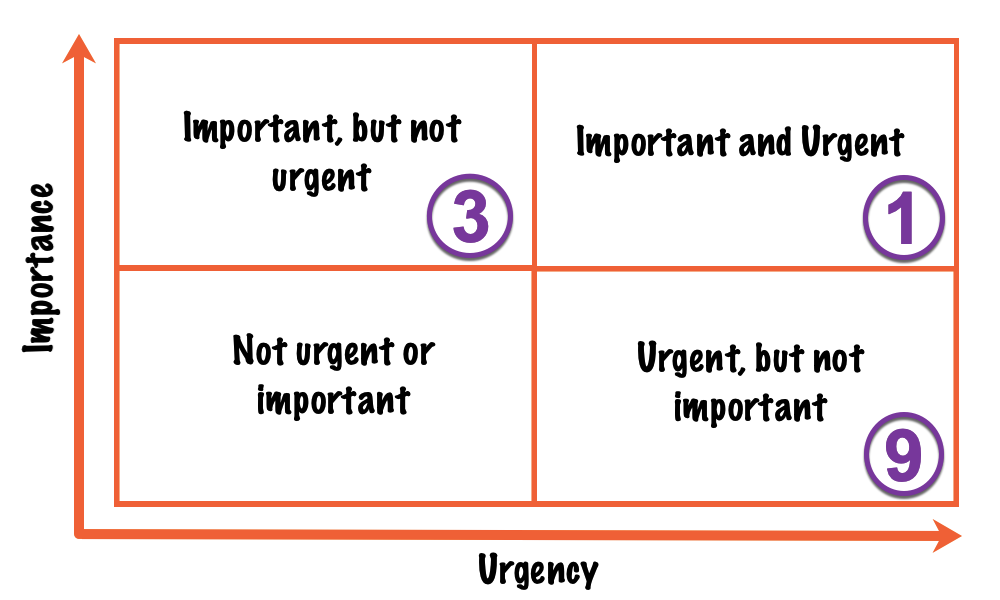
Order your lists of three and nine tasks in terms of priority. Then work on and complete your one task, followed by your three tasks in order, and finally, your nine tasks in order.
In an ideal world, you'd be able to work only on your highest-priority, high-value tasks—but things rarely work out that way. The 1-3-9 method addresses that reality by giving you a way to make sure you're at least working on the most important of your less important tasks.
Any priority matrix app or Kanban app works well with the 1-3-9 prioritization technique.
9. Two lists technique
Warren Buffett's Two lists technique is another really simple approach to prioritizing tasks.
First, you write down a list of 25 things you want to accomplish. When the list is complete, circle the five most important items on that list.
When you're finished, compile the results into two lists:
The first—containing the five tasks you circled—becomes your to-do list.
The second—containing the 20 tasks you didn't circle—becomes your don't-do (yet) list.
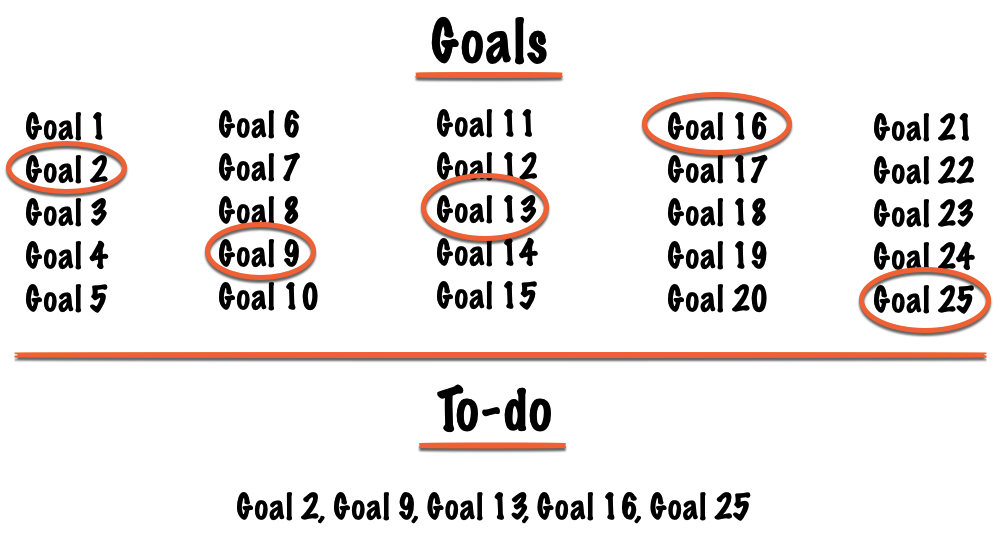
Focus your attention on completing all the tasks on your first list. Only then can you begin working on your second list.
The Two Lists technique is designed to be done on paper, but you can accomplish the same thing with any to-do list app that lets you move tasks from one list to another. Or, if you want to get really creative, turn your 25 goals into a doodle.
10. Pareto principle (80/20 rule)
The Pareto principle, also known as the 80/20 rule, states that 80%of consequences tend to come from 20%. For example, 80% of your impact at work comes from 20% of the tasks you do.
Put another way, if you prioritize a small percentage of the right tasks, they can yield outsized effects.
To put the 80/20 rule into practice, identify your 20% work and make those tasks your priority. There's no hard-and-fast rule baked into the Pareto principle for how to determine your 20% work, but you can draw on other strategies. For example, M tasks from the MoSCoW method or Low effort, high impact tasks from the effort-impact priority matrix.
Bonus: How to prioritize tasks for teams
Many of the prioritization methods listed above are useful for prioritizing your daily tasks. But what if you're working on a larger scale? For example, a product team debating which features to roll out next, or a marketing team deciding how to divide their advertising budget across different campaigns. In those cases, here are a few prioritization methods to help your team identify and sequence those tasks:
How to pick the right task prioritization technique
Every technique on this list helps you achieve the same thing: ensuring that you're always working on your most important tasks. So, in the end, it doesn't matter which technique you use. It doesn't matter if you use multiple techniques. And it doesn't matter if you blend parts of the different techniques to make your own custom method.
What matters is that you pick something that makes sense and feels natural, and get to work.
Related reading:
This article was originally published in July 2019. The most recent update was in September 2023 with contributions from Jessica Lau.
